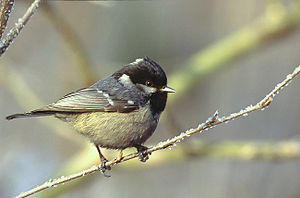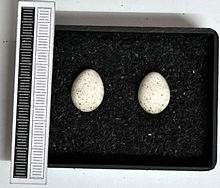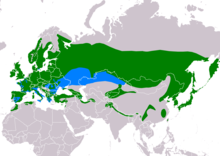Coal Tit
| Coal Tit | ||||||||||||
|---|---|---|---|---|---|---|---|---|---|---|---|---|

Coal Tit ( Periparus ater ) |
||||||||||||
| Systematics | ||||||||||||
|
||||||||||||
| Scientific name | ||||||||||||
| Periparus ater | ||||||||||||
| ( Linnaeus , 1758) |
The tit ( Periparus ater , Syn. : Parus ater ; to Latin ater , dark ') is a bird art in the family of tits (Paridae). In Central Europe, the coal tit is a widespread and very frequent breeding and annual bird.
description
The coal tit is almost 11 centimeters long and weighs between 8 and 10 grams. It has a black crown with a characteristic white patch on the neck, which stands out as a white vertical stripe from the rest of the black neck plumage. She has white or whitish cheeks and a black chin flap. The underside is yellowish to whitish with cream-colored flanks. The top is bluish gray to olive gray with a narrow double white wing band.
The calls sound soft, thin like "si-si" or whirring "sirrrrr". The singing is a high, fast and quiet "wize-wize-wize".
ecology
distribution
The coal tit is a breeding bird of the boreal , temperate and sometimes the Mediterranean zone as well as of the mountain regions of the Palearctic . The distribution area extends from the west coast of Europe and north Africa to the Pacific including Japan. The coal tit is absent in Europe only in the lowland areas of the Mediterranean, in western France and on the western coast of the Black Sea. There are many isolated mountain forest occurrences on the southern edge of the area in Asia.
The population in Europe comprises between 12 and 29 million breeding pairs. In the short term, there may be considerable fluctuations in the population, as coal tits migrate when the population density is high, the seed supply changes in winter or due to climatic factors. The lowest stand numbers coincide with severe winters with poorly growing spruce trees.
nutrition
The diet consists of insects and seeds from various conifers .
habitat
The preferred habitat is the coniferous forest . In mixed forests they look for the conifers . In southern Europe , coal tits are also found in deciduous forests ; in Western Europe they also inhabit gardens . As a result of high progeny, the species tends to invade unpopulated areas. In its vast trans-Palearctic distribution area, which stretches from the Atlantic coast across Eurasia to the Pacific coast, the coal tit is a frequent breeding bird. In Central Europe, it is widely represented in coniferous and mixed forests from the lowlands to the tree line.
Breeding biology

The coal tit lays its nest not only in tree hollows, but also in rock hollows, burrows and crevices. It consists of moss , roots , stalks, lichen and wool. The breeding season in Central Europe extends from April to July. The female incubates 5–12, usually 8–9 eggs for a period of 13 to 16 days. The young are fledged after 18 to 21 days.
Subspecies
So far, 21 subspecies are known:
- Periparus ater britannicus ( Sharpe & Dresser , 1871) is found in Great Britain and the north-east of Ireland .
- Periparus ater hibernicus ( Ingram, W , 1910) is common in Ireland except the northeast.
- Periparus ater ater ( Linnaeus , 1758) occurs in continental Europe and Asia. It is less present from Siberia to Kamchatka , Sakhalin , Korea , in north-east China and in north-east Mongolia .
- Periparus ater vieirae ( Nicholson , 1906) occurs on the Iberian Peninsula .
- Periparus ater sardus ( Kleinschmidt, O , 1903) occurs in Corsica and Sardinia .
- Periparus ater atlas ( Meade-Waldo , 1901) is common in Morocco.
- Periparus ater ledouci ( Malherbe , 1845) occurs in northern Algeria and northern Tunisia .
- Periparus ater cypriotes ( Guillemard , 1888) is common in Cyprus .
- Periparus ater moltchanovi ( Menzbier , 1903) occurs in the south of the Crimea .
- Periparus ater michalowskii ( Bogdanov , 1879) occurs in the Caucasus with the exception of the southwest and in the central and eastern South Caucasus .
- Periparus ater derjugini Zarudny & Loudon , 1903 is widespread from northeast Turkey to the southwest of the Caucasus.
- Periparus ater eckodedicatus ( Martens, J , Tietze & Sun , 2006) occurs in western China.
- Periparus ater phaeonotus ( Blanford , 1873) occurs in south-east Azerbaijan , north Iran and south-west Turkmenistan . It could be that the subspecies visits southwest Iran in winter.
- Periparus ater rufipectus ( Severtsov , 1873) occurs from southeast Kazakhstan to northwest China.
- Periparus ater martensi ( Eck, S , 1998) is common in the area of Kali Gandaki .
- Periparus ater melanolophus ( Vigors , 1831) occurs from eastern Afghanistan through northwestern Pakistan to the northwestern Himalayas .
- Periparus ater aemodius ( Blyth , 1845) occurs in the east of the Himalayas to the north of Myanmar .
- Periparus ater pekinensis ( Verreaux, J , 1868) is widespread in east-central China.
- Periparus ater insularis ( Hellmayr , 1902) is common in the south of the Kuril Islands and in Japan .
- Periparus ater kuatunensis ( La Touche , 1923) occurs in southeast China.
- Periparus ater ptilosus ( Ogilvie-Grant , 1912) occurs in Taiwan .
Single receipts
- ↑ Bauer et al., P. 112
- ↑ Bauer et al., P. 113
- ^ IOC World Bird List Finches, Waxwings and allies, tits, penduline tits
literature
- Hans-Günther Bauer, Einhard Bezzel and Wolfgang Fiedler (eds.): The compendium of birds in Central Europe: Everything about biology, endangerment and protection. Volume 2: Passeriformes - passerine birds. Aula-Verlag Wiebelsheim, Wiesbaden 2005, ISBN 3-89104-648-0 .
- Urs N. Glutz von Blotzheim (Hrsg.): Handbook of the birds of Central Europe . Edited by Urs N. Glutz von Blotzheim and Kurt M. Bauer, among others. Volume 13 / I, Passeriformes (4th part), Muscicapidae - Paridae . Aula-Verlag, Wiesbaden 1993, pp. 523-578. ISBN 3-89104-022-9 .
Web links
- Periparus ater in the Red List of Threatened Species of the IUCN 2013.1. Listed by: BirdLife International, 2012. Retrieved September 19, 2013.
- Videos, photos and sound recordings on Periparus ater in the Internet Bird Collection
- Age and gender characteristics (PDF; 2.8 MB) by Javier Blasco-Zumeta and Gerd-Michael Heinze (English)
- Coal tit feathers



